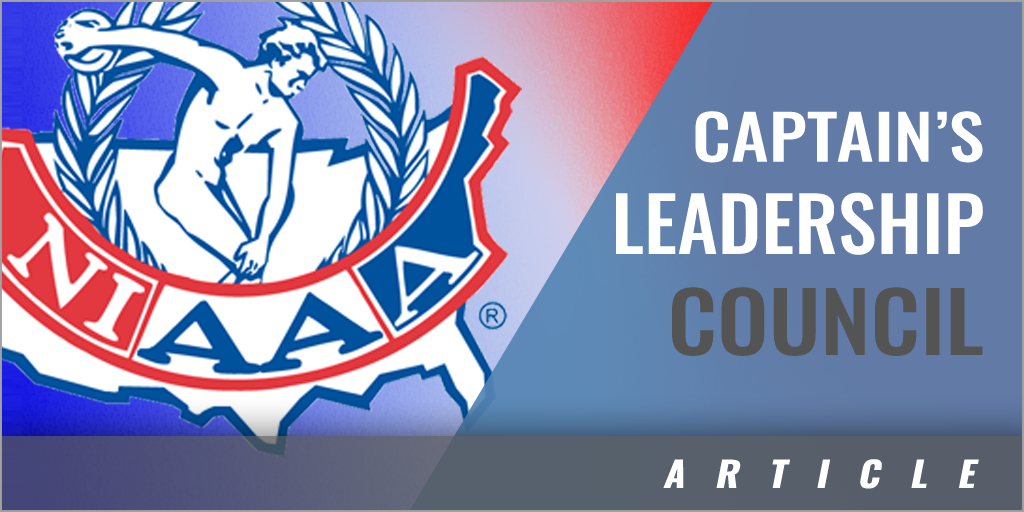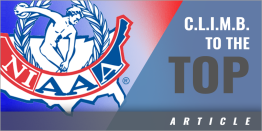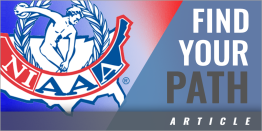|
By: Anne Campbell, CMAA and Ryan Frost, CMAA While we had never met before, after our first phone conversation about Captain's Council, we knew we were a good fit. We are both very passionate about providing educational opportunities to our student-athletes. Ryan works as an AD in New Hampshire at a private boarding school for boys 6-8th grade. Anne works in northern Minnesota as an AD at a public rural school, 9-12th grade. We each had similar reasons for establishing a Captain's Leadership Council (CLC):
As you think about starting your CLC, it's important to think of the purpose for your program - the why, what brings us to the table. For us, it is to provide educational opportunities and activities for student-leaders. How could we help them become better students, effective leaders, and responsible citizens? The objectives and desired outcomes must be clear. Ryan established objectives for his CLC for the following reasons:
Anne's desired outcomes for her student leaders in CLC include:
Along with objectives and outcomes, expectations for students need to be defined:
As we said at the beginning of the article, the key to getting a CLC off the ground is to just GO. Here is how we started our CLC programs at our schools: Ryan had the opportunity to start two different CLC programs at two very different schools. The first school was a pre-K-12 private day school where he and the field hockey head coach saw a need for leadership training and development and worked to start a year-long program for the high school varsity captains of all teams. The program was started in spring 2005, designed and facilitated around Jeff Janssen's The Team Captain's Leadership Manual. Captains of each team met twice a month to learn about leadership, to work with their peers and coaches, and to learn ways to support and improve the desired culture of the athletic program and the school. When Ryan transitioned to Cardigan Mountain School, he started a slightly different form of his Captain's Council model that fit his new school. Cardigan is an all-boys boarding school for grades 6 through 9. All students are required to participate in a sport all three seasons – because of this Ryan structured his CLC into three different time frames. A different group of captains is set up each season, and meetings take place 5-6 times during each season. One difference is that all sports and all teams no matter the level are represented in the meetings each season, and all grades and experience levels are there working, learning, and growing together. At the time Anne interviewed for her AD position, the administration had wanted a Captain's Council type of leadership program for the students, but the initiative needed to be designed, planned, and implemented. She reached out to schools that already had the program, as well as the Minnesota State High School League, and incorporated resources from her time as a head coach to build this program. She was able to make it her own from the roots up. The first CLC meeting was held in the Fall of 2012 and has been going strong for eight years. At the end of each meeting, her goal is for each student to take with them one thing to reflect upon and bring back to their team. At Grand Rapids High School, the CLC meets once a month before school starts for 45 minutes with all captains from activities and athletics. Up to 50 students commit to attending monthly. Leaders who meet the attendance requirement are recognized at the end of the school year event. Anne uses the Science of the Positive to frame her meetings. The Science of the Positive, created and developed by Jeff Linkenbach (of the Montana Institute), is a study of how positive factors impact culture and experience. The core assumption is that the positive is real and worth growing in ourselves, our families, our schools, and our community. The framework consists of the Spirit, Science, Action, and Return. When these four stages are engaged, it creates a continuous cycle of positive transformation. Spirit: The purpose and why of what we are doing. It's positive and hopeful. Science: It's what we know, the data, learning, planning, and effectiveness. Action: It's what we do, getting it done. Return: Looking back at where we have been, reflecting and evaluating. Using the Science of the Positive has helped to implement and plan activities for the CLC and to make sure that sessions are relevant and worthwhile to the students. Our CLC has steadily shifted the culture of our school over the years and infused a lot of pride into our school and community. At Cardigan, Ryan breaks the CLC each year into three different groups by season as new teams and captains are selected. During each season, all the captains for that season (typically around 30 boys) take part in our CLC, no matter the age or level of the team they represent. This creates a diverse group of learners, ranging from no experience to those who may have even been a captain in a previous season. We typically have 5-6 meetings each season lasting about an hour. One struggle, even at a boarding school, is finding a meeting time that works for everyone. We started with "0'dark 30" meetings as we called them happening before and during breakfast. We have since moved our meeting time around our lunch block, so we have all the kids together in the same place at the same time. Meetings start with the kids grabbing their food and either taking in a quick video, reading a handout or doing an individual assignment to help introduce the topic or theme of the meeting while they eat. We review the agenda and theme as well as any quotes of the day to set the tone. This allows for transition, settling and getting some food in their bellies. We then unpack the opening and how it might relate to the topic of the day and their leadership or their team. After this, we often do the bulk of our teaching using multiple teaching techniques to reinforce the topic of the day. These topics might include:
We use different teaching modalities to support the topic of the day and reinforce their learning and buy-in. These can vary a great deal but have included:
We then bring the group back together to wrap up and give final thoughts before our closing exercise, "The Good, The Bad, The Ugly, and Moments of Greatness," along with any assignments/announcements. "The Good, The Bad, The Ugly, and Moments of Greatness" is when our captains share these items from their teams or campus life from the previous week. Through this forum, captains can celebrate successes, sympathize with struggles and help work through each other's challenges. Captains can help support one another, learn from mistakes, grow from their collective wisdom and realize they are not alone and all face similar struggles no matter the sport or the level of play. We encourage our student-athletes to provide feedback and any issues relevant to them about the athletic program or other areas of school life they like, don't like, or offer suggestions for additions or improvements. This also gives the AD or facilitating adults the opportunity to provide context and background for decisions. This hopefully creates greater student leader buy-in and allows captains to disseminate information and understanding to their peers and the community. Both Ryan and Anne believe and implement a feedback and evaluation session, so we can grow and improve. At the end of each season or school year, we ask the captains to fill out an evaluation form. We want to know if they felt the CLC was meaningful, what they enjoyed, did not enjoy, as well as what we can do to make this time even more valuable. It's also essential to ask for topic suggestions such as situations they are struggling with, or things that come up on campus or during the school day that they would like to discuss. The bottom line is, the CLC is their program. We as ADs are here to help and serve them as they provide service to their teams and their program and make a positive impact at their school. Jim Trinka and Les Wallace said it best, "Feedback is a gift. Ideas are the currency of our next success. Let people see the value in both feedback and ideas." It is important that you plan and have an agenda laid out for your next meeting. There are so many resources and activities that you can apply. We both have created handbooks and folders of lesson plans. We both have used ideas from Jeff Janssen, the Positive Coaching Alliance, NFHS materials, our local state organizations, video clips, guest speakers, current issues, other ADs, and our own coaching experiences. We have attached a QR code at the bottom of this article that you can scan to obtain the resources we have used to build and sustain our CLCs. We wish you much success in this endeavor. Just jump in and GO! If you need a push, please contact rfrost@cardigan.org or acampbell@isd318.org, we are here to assist. "Leadership and learning are indispensable to each other." - John F. Kennedy Leaders never stop learning! |







